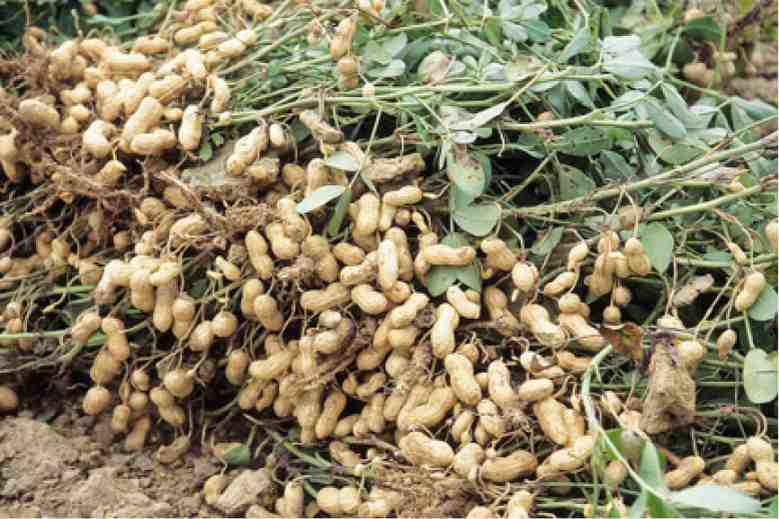Preventing your groundnuts from aflatoxins contamination right from farm
3 new improved varieties (Sumnut 24, 25 and 26) now available Aflatoxins concentration in all the local groundnut varieties produced in Nigeria is said to be as high as 392 micrograms per billion which is about 20 times higher than the 20 micrograms per billion permissible aflatoxins contamination limit set by the Standard Organization of […]

Preventing your groundnuts
3 new improved varieties (Sumnut 24, 25 and 26) now available
Aflatoxins concentration in all the local groundnut varieties produced in Nigeria is said to be as high as 392 micrograms per billion which is about 20 times higher than the 20 micrograms per billion permissible aflatoxins contamination limit set by the Standard Organization of Nigeria (SON) on groundnut produced in the country.
Aflatoxins is a poisonous substance produced by some fungi on crops that lives in soil and decayed materials. When its spore is released, it can infect crops on farm, reproduce in stores and even in processed product.
Since the 1975 groundnut disaster in the country, when over 7.5 million hectares of groundnut was destroyed as a result of the emergence of groundnut rosette disease, there has not been any variety as resistant as the recently developed improved Sumnut 24, 25 and 26 variety in the country.
The introduction of good agricultural practice among the majority of the resource-limited farmers is key in managing aflatoxins contamination in groundnut production in the country. That is by way of promoting the use of the most appropriate seed, timely planting, regular weeding, timely harvesting at maturity as well as adequate drying of crop after harvest as against bio control measures.
Speaking to Daily Trust on promoting the production of aflatoxins-free groundnut in the country, the Project Country Manager of the International Crop Research Institute for the Semi-Arid Tropics (ICRISAT), who is working on groundnut technology upscaling project in Jigawa State, Dr. Vabi Boboh Michael, said aflatoxins contamination could be controlled right from the farm field as against the common practice of applying biocontrol measures.
He explained that the safety of groundnut begins right from the selection of seed because when a farmer planted an infected seed, he is also bound to harvest infected produce.
Aflatoxins affect the seed of groundnut when the shell is eaten up by termites or any insects at the farm. It is based on this that farmers are advised not to patronize termites infested areas or any field that has a history of insects’ infection for groundnut production.
Farmers should weed their farms regularly and at the right time as failure to keep the farm clean promotes the chances of the groundnut farm field producing aflatoxins contaminated groundnut pods. Farmers should also not delay harvesting their produce beyond the maturity period.
In a situation whereby harvesting of groundnut is delayed beyond the appropriate period, indeterminate cropping sets in where the pod will start re-growing and this increases the chances of aflatoxins contamination on the produce.
After harvest, the groundnut should be left in the farm for a period of about five to seven days to dry before removing the pods from their stems.
At this stage, farmers are also advised to take their time by ensuring that all broken pods are removed from the produce. This safety management must be thorough because broken pods are roots to aflatoxins contamination.
While bagging for storage, the produce must be kept in a place with sufficient supply of air and on planks. It must not be allowed to have contact with the ground or floor of the store as the case may be.
Dr. Boboh Michael also said the introduction of the new improved varieties of groundnut that have lower aflatoxins contamination than even the national standard of between eight to 15 micrograms per billion, reduced the risk of the high incidences of contamination from the local varieties.
The improved variety does not only reduce the cases of contamination but also improved the yield per hectare of groundnut. Sumnut 24, 25 and 26 give as much as 2.5 tons per hectare as against 1.2 tons per hectare from the local variety.
The new variety enjoys early maturity of between 90 to 95 days as against the local variety which lasts as much as 120 to 150 days before being ready for harvest.
He said: “International Crop Research Institute For The Semi-Arid Tropics (ICRISAT) has introduced three improved varieties of groundnut to farmers in Jigawa State – Sumnut 24, 25 and 26 – with a view to improve yield per hectare and reduced the high level aflatoxins contamination commonly found in the local variety of the crop.
“Under good management, each of the newly introduced improved varieties can give as much as 2.5 tons per hectare as against the local variety with a highest tonnage of 1.2 per hectare.
“Safety of groundnut crop begins from the farm field. Aflatoxins contamination in groundnuts is largely as a result of termites and other insects. To ensure aflatoxins free groundnuts without application of biocontrol measure, farmers must patronise improved varieties as well as ensure the use of termites free farm fields,” the Project Country Manager stated.
